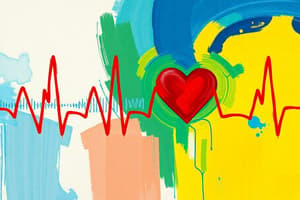Podcast
Questions and Answers
What is ventricular tachycardia (VT)?
What is ventricular tachycardia (VT)?
Administer epinephrine 1mg IVP, check for pulse & call code, caused by hyperkalemia, priority intervention is defibrillation.
What is sinus tachycardia (ST)?
What is sinus tachycardia (ST)?
Complication as a result of rhythm in patient with longstanding CAD, angina, CHF. Patient just started on Adderall, has anxiety, dehydration, fever. Priority intervention is to check patient's temperature and fluid volume status.
What is ventricular fibrillation?
What is ventricular fibrillation?
What can cause sinus bradycardia?
What can cause sinus bradycardia?
What is a paced rhythm?
What is a paced rhythm?
What are the characteristics of Mobitz type 2 heart block?
What are the characteristics of Mobitz type 2 heart block?
What defines normal sinus rhythm (NSR)?
What defines normal sinus rhythm (NSR)?
What can occur in atrial flutter?
What can occur in atrial flutter?
What is sinus rhythm with PVCs?
What is sinus rhythm with PVCs?
What characterizes Wenckebach/2nd degree heart block type 1?
What characterizes Wenckebach/2nd degree heart block type 1?
What is pacemaker failure to capture?
What is pacemaker failure to capture?
What is supraventricular tachycardia (SVT)?
What is supraventricular tachycardia (SVT)?
What is asystole?
What is asystole?
What does atrial fibrillation (AFIB) entail?
What does atrial fibrillation (AFIB) entail?
What is 3rd degree heart block?
What is 3rd degree heart block?
What is bigeminy?
What is bigeminy?
What is pacemaker failure to pace?
What is pacemaker failure to pace?
What is sinus rhythm with PVC couplet?
What is sinus rhythm with PVC couplet?
What is trigeminy?
What is trigeminy?
What is a bundle branch block?
What is a bundle branch block?
What is normal sinus rhythm with PVC triplet?
What is normal sinus rhythm with PVC triplet?
What defines 1st degree heart block?
What defines 1st degree heart block?
Flashcards are hidden until you start studying
Study Notes
Ventricular Tachycardia (VT)
- Administer 1 mg epinephrine IV push.
- Check for pulse and initiate code if necessary.
- Commonly caused by hyperkalemia.
- Priority intervention is defibrillation.
Sinus Tachycardia (ST)
- Can result from long-standing CAD, angina, or CHF.
- Triggered by recent Adderall use, anxiety, dehydration, or fever.
- Key interventions include checking temperature and fluid volume status; caffeine reduction is recommended.
Ventricular Fibrillation
- Life-threatening cardiac rhythm characterized by chaotic electrical activity in the ventricles.
Sinus Bradycardia
- May be normal in highly conditioned athletes.
- Can lead to low blood pressure and symptoms like dizziness, weakness, and fainting.
- Potentially caused by medications like lanoxin, beta-blockers, and narcotics.
- Intervention may include atropine IV to increase heart rate above 60 bpm.
Paced Rhythm
- Represents a heart rhythm under the influence of a pacemaker.
Mobitz/2nd Degree Heart Block Type 2
- Involves irregular pulse and typically a slow heart rate due to bundle branch issues.
- At risk of progressing to complete heart block; monitoring CKMB and troponin levels is essential.
- Echo may assist in assessment, and atropine or a pacemaker may be required if symptomatic.
Normal Sinus Rhythm (NSR)
- Characterized by a heart rate of 60-100 bpm and a narrow QRS complex.
Atrial Flutter
- Symptoms include fatigue and shortness of breath; heart rate of 240-340 bpm with no PR interval.
- Key monitoring for progression to atrial fibrillation is essential.
- Treatment options include cardioversion and carotid massage, along with beta-blockers and anticoagulants to prevent thrombus formation.
Sinus Rhythm with PVCs
- Presence of premature ventricular contractions alongside a normal sinus rhythm.
Wenckebach/2nd Degree Heart Block Type 1
- Identified by a progressively lengthening PR interval until a QRS complex is dropped.
- Check troponin and CKMB levels as a priority intervention.
Pacemaker Failure to Capture
- Represents a situation where the pacemaker does not effectively stimulate the heart.
Supraventricular Tachycardia (SVT)
- Treatment includes 120 mg verapamil orally three times a day and 6 mg adenosine IV push.
- Ensure a patent IV line is established for medication administration.
Asystole
- Characterized by absence of electrical activity in the heart.
- Administer 1 mg epinephrine IV push; continuous chest compressions and BVM ventilation are critical.
Atrial Fibrillation (AFIB)
- Most common in older adults; associated with uncontrolled hypertension.
- Key assessments include monitoring PT, INR, PTT to evaluate bleeding risks.
- Treatment options may include anticoagulants, cardioversion, and medications like calcium channel blockers or cordarone.
3rd Degree Heart Block
- Administer 1 mg atropine IV and prepare for transcutaneous pacing.
- Signs include dizziness and weakness; prioritize risk for falls related to fatigue.
Bigeminy
- A rhythm where every other heartbeat is a premature contraction; monitored risk for fluid volume overload due to decreased cardiac output.
- Monitor potassium, calcium, and magnesium levels.
Pacemaker Failure to Pace
- A condition indicating the pacemaker's inability to generate electrical impulses.
Sinus Rhythm with PVC Couplet
- ECG finding of two consecutive PVCs occurring in a sinus rhythm pattern.
Trigeminy
- A rhythm where every third heartbeat is a PVC; warrants close monitoring.
Bundle Branch Block
- A conduction delay or blockage in the heart's electrical pathways affecting cardiac rhythm.
Normal Sinus Rhythm with PVC Triplet
- ECG finding showing a normal rhythm interrupted by three consecutive PVCs.
1st Degree Heart Block
- Identified by a prolonged PR interval; no beats are dropped, and symptoms might be absent.
- Monitoring electrolytes and echo may be necessary, but treatment isn't required if asymptomatic.
Studying That Suits You
Use AI to generate personalized quizzes and flashcards to suit your learning preferences.




